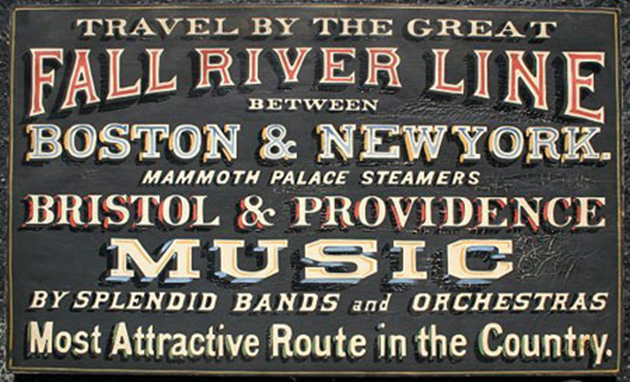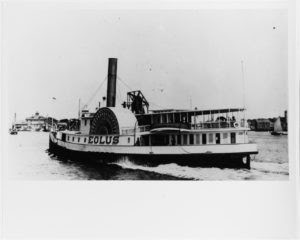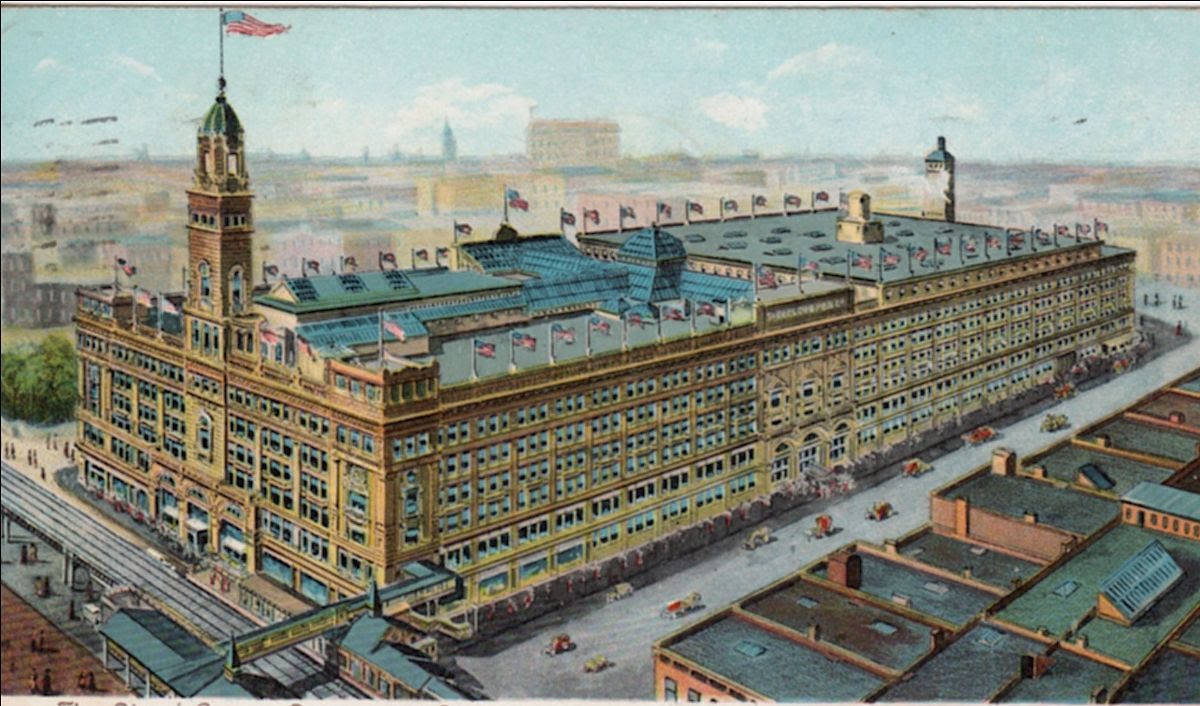Friday, July 30, 2021 – The Age of Glamorous Steamboats on the East River
FIND OUT MORE ABOUT THE R.I.H.S.
WE WELCOME ALL TO LEARN ABOUT THE SOCIETY.
Our next board meeting is scheduled for Wednesday, August 11th at 5 p.m. Please tell me if you want in-person or Zoom. All members and friends and those just curious are invited to attend. E-mail or text if you are interested in attending.


FRIDAY, JULY 30, 2021
The
429th Edition
The Age of Glamorous
Steamboats
on the East River
STEPHEN BLANK

The Age of Glamorous Steamboats on the East River
Stephen Blank
In my last essay, I described how splendid steamboats plied the East River as well as the Hudson. The most dazzling of these were the steamboats of the Fall River Line. Fall River Line was a combination steamboat and railroad connection between New York City and Boston that operated between 1847 and 1937. (Note, I have drawn heavily in this piece from two super articles on the Fall River Line by Michael Grace.)
What’s most interesting to me is that this combo line continued to operate – and to be a social high point – not only through the great rail era in the US but well into the time of air travel as well. It became a continuing element of high society. The Fall River Line also provides a window on the internecine struggles of the great robber barons of the Gilded Age.
Old Colony Railroad
Let’s begin with the landside, the Old Colony Railroad. The OC was a major railroad system which operated from 1845 to 1893. Its network ran from New York to Boston and southeastern Massachusetts. For many years, the OC also operated steamboat and ferry lines, including the Fall River Line. It grew by mergers and acquisitions until it was itself acquired by the New York, New Haven and Hartford Railroad in 1893. The acquisition was part of J. P. Morgan’s plan to monopolize New England transportation, including railroads and steamship lines, and build a network of electrified trolley lines to provide interurban transportation for all of southern New England. By 1912, Morgan’s railroad practically monopolized traffic from Boston to New York City.

Fall River Line
The Fall River Line, known originally as the Bay State Steamboat Company, was launched in 1847, backed, among others, by members of the Borden family (remember Lizzie?). Sailing from New York, the Fall River boats steamed up the East River in the early evening; up to Hell Gate, then down the Long Island sound; calling at Newport in the middle of the night and in the morning landing at the Fall River dock. Boston was just a train ride away with connections north to Maine’s major cities and resorts.
Michael Grace writes “Of all the fleets that plied the Sound, there was never any quite like the Fall River Line. Songs were written about it. Nearly all the presidents and most of the great men and women of that long period traveled it—the famous boat train from Boston in the late afternoon, then off the cars and into the boat at the Fall River wharf, in time to dine in the line sea air while steaming down Narragansett Bay, past Newport, to head around treacherous Point Judith and thence westward through The Race into the Sound. A fine sleep and into New York in time for business in the morning: it was the recommended route.”
The Fall River Line’s first steamer was the Bay State, 300 feet long and forty wide, lit by oil lamps at night. Her cuisine attained considerable renown, at fifty cents for the grand table d’hôte dinner, served at long candlelit tables. These were no ferry boats, and they were modeled on the grand manner of the transatlantic trade. The line was so profitable that two new boats, the Empire State, and the Metropolis, could be bought out of profits in a few years. Soon, Wall Street men moved in to begin a series of major financial mergers and shufflings which lasted over many years.


One “Wall Street man” in particular is remembered, “Admiral” Jim Fisk (“If Vanderbilt’s a Commodore, I can be an Admiral!”) soon to be owner of everything from railroads to judges. Representing some Boston capitalists, he outsmarted Daniel Drew, a longtime rival of Vanderbilt, into selling out his rival steamboat interest, and this gave him power as the president of a great steamboat line.
After Fisk’s death, when his mistress’s other lover shot him on the stairs of the Grand Central Hotel, the line was restructured, becoming the Old Colony Steamboat Company, under railroad control. Later it was absorbed, along with the Old Colony Railroad, by Morgan’s New Haven in the 1890’s.
Competition was brisk, principally from the Stonington Line, which was called “Old Reliable,” only to run two of its best ships aground one after the other, and then to have two others, the sister ships Narragansett and Stonington, collide off Cornfield Point, near Saybrook, Connecticut, with a loss of 27 lives. Presently this line too was swallowed up in the Morgan mergers.
But the Fall River Line, with the largest and most magnificent and most perfectly equipped river going vessels in the world, remained preeminent. Its modern steam-electricity technology, brightened by music from top groups, and with grand meals in the elegant dining salon attracted the nation’s social leaders. The palatial steamboats Priscilla and Commonwealth were the greatest of the Fall River Line fleet. These ships, it was claimed, could carry as many passengers and as much freight as the great Atlantic liners, Lusitania and Mauretania, on about one-sixth the displacement. Their accommodations, it was said, were often superior to those on all but the most luxurious North Atlantic liners. With over 300 first class staterooms, plus 15 parlor bedroom suites, a crew of 250 needed to operate the Priscilla and Commonwealth.
Grace: “No steamship service under the American flag, not excluding the North Atlantic liners, was more beloved by the traveling public than the Fall River Line or more greatly mourned when it was no more. A naval architect wrote, ‘The passenger steamers of the Fall River Line are absolutely the finest ships in the world for passenger service on inland waters. We may well be proud of the Fall River Line boats as creations distinctly American along with the elegance and service found in the greatest European hotels.’”
Newport and Wickford Railroad and Steamboat Company
The Gilded Age wealthy traveled elsewhere as well, to less trafficked destinations where they built vast summer “cottages”, namely Newport and Conanicut Island and Narragansett. Getting there was not convenient. A group of well to do New Yorkers decided to make things easier. Cornelius Vanderbilt II and his brother Frederick, formed the Newport and Wickford Railroad and Steamboat Company with several other investors. Other members of the board included political figures like Senator George Peabody Wetmore and Congressman George Gordon King. They constructed and operated a rail line a mere three-and-a half miles long. The track ran from the mainline New York, Providence & Boston stop at Wickford Junction to the port of Wickford, where a company-owned steamboat could bring passengers across to Newport. The little steamboat was not grand, but its passengers were. The N&W began service in 1871, the start of the Gilded Age, and managed to provide combined rail and steamship service until 1925.

Travelers were soon arriving from as far away as Chicago and St. Louis. The private rail cars of the wealthy New Yorkers were backed onto the siding where the N&W’s sole locomotive patiently waited to haul them to Wickford Harbor. For those without a private Pullman parlor car, the mainline railroad added a “Newport Car” reserved for passengers also heading to the City by water.
The Sad End
But no dream lasts forever and our grand steamers were finally junked or sold. Why? The opening of the Cape Cod Cana created a faster and safer all water route. Cheaper New York-Boston rail service diminished demand. Most of all, the private automobile and an improving road network was the most important factor. As the Great Depression wore on, line after line disappeared until only the Fall River route remained of all the once far-flung New Haven Railroad steamboat network.
Last words from Michael Grace, “… a generation has grown up since the line stopped operating in 1937, a generation which never strolled the deep-carpeted saloon and decks, eyeing the drummers and men of property and occasional flashy women, and never awoke to peer through the porthole at Hell Gate Bridge and take a hearty breakfast while the ‘mammoth palace steamer’ steamed round the Battery and swung into her Hudson River berth.”
Goodness, goodness, goodness. Don’t you wish you had had the opportunity to sail on the Fall River Line? (And those “flashy women”.)
Stephen Blank
RIHS
July 15, 2021
FRIDAY PHOTO OF THE DAY
SEND YOUR SUBMISSION
TO ROOSEVELTISLANDHISTORY@GMAIL.COM

THURSDAY PHOTO OF THE DAY
SIEGEL COOPER DEPARTMENT STORE
18-19 STREETS ON SIXTH AVENUE

Text by Judith Berdy
Thanks to Bobbie Slonevsky for her dedication to Blackwell’s Almanac and the RIHS
Thanks to Deborah Dorff for maintaining our website
Edited by Melanie Colter and Deborah Dorff
All image are copyrighted (c)
STEPHEN BLANK
SOURCES
FUNDING PROVIDED BY ROOSEVELT ISLAND OPERATING CORPORATION PUBLIC PURPOSE GRANTS CITY COUNCIL REPRESENTATIVE BEN KALLOS DISCRETIONARY FUNDING THRU DYCD


Copyright © 2021 Roosevelt Island Historical Society, All rights reserved.Our mailing address is:
rooseveltislandhistory@gmail.com

Leave a comment